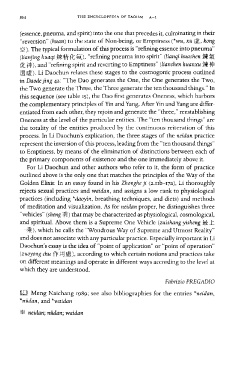Page 597 - The Encyclopedia of Taoism v1_A-L
P. 597
554 THE ENCYCLOPEDIA OF TAOISM A-L
(essence, pneuma, and spirit) into the one that precedes it, culminating in their
"reversion" (huan) to the state of Non-being, or Emptiness (*wu, xu J1fi., kong
2). The typical formulation of this process is "refining essence into pneuma"
(lianjing huaqi ilUi1'{{Jr~O, "refining pneuma into spirit" (lianqi huashen i**t
{t frjl), and "refining spirit and reverting to Emptiness" (lianshen huanxu i* f$
i!tIilit). Li Daochun relates these stages to the cosmogonic process outlined
in Daode jing 42: "The Dao generates the One, the One generates the Two,
the Two generate the Three, the Three generate the ten thousand things." In
this sequence (see table IS), the Dao first generates Oneness, which harbors
the complementary principles of Yin and Yang. After Yin and Yang are differ-
entiated from each other, they rejoin and generate the "three," reestablishing
Oneness at the level of the particular entities. The "ten thousand things" are
the totality of the entities produced by the continuous reiteration of this
process. In Li Daochun's explication, the three stages of the neidan practice
represent the inversion of this process, leading from the "ten thousand things"
to Emptiness, by means of the elimination of distinctions between each of
the primary components of existence and the one immediately above it.
For Li Daochun and other authors who refer to it, the form of practice
outlined above is the only one that matches the principles of the Way of the
Golden Elixir. In an essay found in his Zhonghe ji (2.nb-I7a), Li thoroughly
rejects sexual practices and waidan, and assigns a low rank to physiological
practices (including *daoyin, breathing techniques, and diets) and methods
of meditation and visualization. As for neidan proper, he distinguishes three
"vehicles" (sheng *) that may be characterized as physiological, cosmological,
and spiritual. Above them is a Supreme One Vehicle (zuishang yisheng ~ L
- '*), which he calls the "Wondrous Way of Supreme and Utmost Reality"
and does not associate with any particular practice. Especially important in Li
Daochun's essay is the idea of "point of application" or "point of operation"
(zuoyong chu it m ~), according to which certain notions and practices take
on different meanings and operate in different ways according to the level at
which they are understood.
Fabrizio PREGADIO
m Meng Naichang 1989; see also bibliographies for the entries *neidan,
*niidan, and *waidan
* neidan; niidan; waidan

